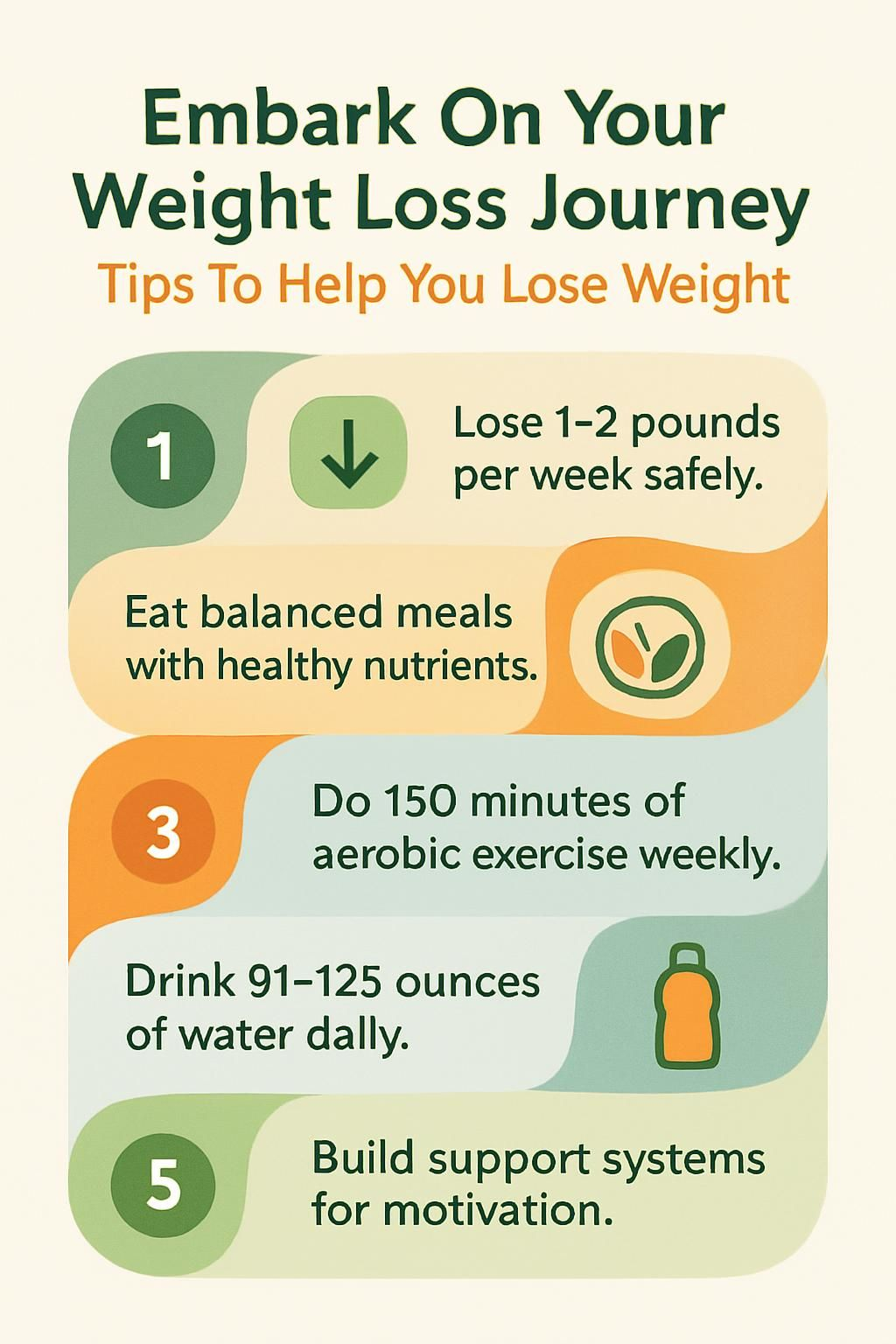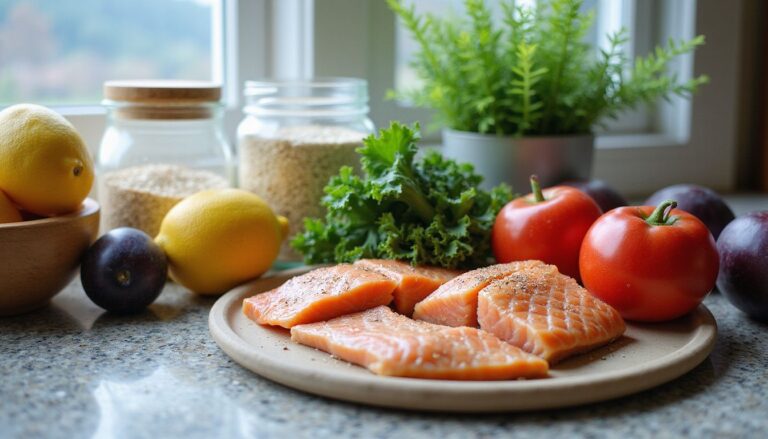Embark On Your Weight Loss Journey: Tips To Help You Lose Weight
Our Nutrition Assistant AI Suite will transform your body. You will lose fat, get toned, and build muscle. Gain confidence and optimal health.
You might feel stuck if your weight loss journey stalls, even with healthy meals and regular exercise. Lasting progress usually comes from steady lifestyle changes, not quick fixes or fad plans. This guide offers clear steps to help you lose weight, from setting goals you can live with to building smarter eating habits and staying active week after week.
You will find simple actions that fit busy days. Small changes, done often, lead to big results over time. If you have a medical condition or take prescriptions, talk with your healthcare professional before making major changes to your diet or physical activity.
Key Takeaways
- Set SMART goals and track weekly. Aim to lose 1 to 2 pounds per week, a safe pace supported by experts.
- Prioritize lean protein, fiber, and healthy fats. Limit highly processed foods to support weight management and reduce disease risk.
- Combine 150 minutes of moderate cardio each week with strength training twice weekly to burn calories and protect muscle.
- Stay hydrated. A general target is about 91 ounces daily for women and 125 ounces for men, including all fluids.
- Build support, expect plateaus, and stay consistent. Patience helps you create routines that keep a healthy body weight.

Define Your Motivation for Weight Loss

Motivation powers your weight-loss efforts. Knowing your reasons helps you push through hard days and stick with change.
What motivates me to lose weight?
Understanding health risks can spark action. Extra weight raises the chance of heart disease, type 2 diabetes, and some cancers. Setting a goal to lower your body mass index, which is a height to weight measure, gives you a clear target.
List your personal reasons and keep them visible. Sticky notes on the fridge or a lock screen reminder can help on tough evenings. Ask yourself how you will handle stress, social events, and cravings before you start. That plan makes healthy routines feel more rewarding, like fitting old jeans again or keeping up with your kids.
Motivation gets you started, habit keeps you going.
How does weight loss improve long-term health and well-being?
Losing 5 percent of your current weight can improve blood pressure, cholesterol, and blood sugar. For someone at 200 pounds, losing 10 pounds can matter. These changes lower the risk of heart disease and type 2 diabetes over time.
Regular physical activity helps you burn more energy and lose fat while keeping muscle. Less body weight also reduces joint strain and can improve sleep apnea. Even small changes, like eating more whole grains and fewer sugary snacks, support steady wellness.
Better energy and mood often follow because your metabolism and appetite hormones, like leptin and ghrelin, work more smoothly. You are building health, not just chasing a number on the scale.
Set Realistic Goals
Realistic goals make progress feel possible. Steady wins protect your health and help results last.
What is SMART goal-setting and how do I use it?
SMART goals are Specific, Measurable, Achievable, Relevant, and Time-bound. Instead of saying, I want to lose weight,
try, I will walk 15 minutes after dinner on Mondays, Wednesdays, and Fridays for the next month.
That target is simple to track.
Pick goals that move you toward health, not just a lower number. Short-term targets like eating vegetables at two meals per day or skipping sugary drinks on weekdays build habits that compound. People who use SMART plans often make more progress than those with vague aims.
How can I break my goals into smaller steps?
Break big goals into small, clear tasks. That approach keeps your focus on today and reduces overwhelm.
- Choose a safe pace, like losing 1 to 2 pounds weekly.
- Set action goals, for example, walk 30 minutes daily or eat five servings of produce.
- Track your weight weekly in a journal or app to spot trends early.
- Swap refined grains for whole grains and add more high-fiber plants to feel full on fewer calories.
- Limit sugary drinks and make water your default to cut cravings.
- Do strength training twice a week to protect muscle as you lose body fat.
- Meet a registered dietitian for tailored guidance and problem solving.
- Reward milestones with non-food treats that do not trigger binge patterns.
- Complete one or two small tasks daily. Consistency builds sustainable eating patterns.
Adopt a Healthy Diet
A healthy diet supports weight loss and lowers the risk of cardiovascular disease. Balanced choices help you match eating with physical activity so progress sticks.
What are nutrient-rich, whole foods to prioritize?
Fill most of your plate with vegetables and fruits. Aim for several servings each day. Choose whole grains like brown rice, quinoa, and oats instead of white bread or traditional pasta. Whole grains deliver more fiber, which helps you stay full.
Use healthy fats such as olive oil and nuts, but mind portions since they are calorie dense. Pick low-fat or fat-free dairy if you want protein with less saturated fat. Fresh or minimally processed foods help you avoid excess sugar, salt, and additives found in many packaged snacks.
On my own path, I swapped chips for sliced bell peppers at lunch. The crunch stayed, the calories dropped, and I felt satisfied longer.
How can I limit processed and sugary foods?
Start with easy swaps. Cut back on desserts, pastries, and soda. Choose fruit to satisfy a sweet tooth. Read labels to spot hidden sugar in sauces, yogurt, and cereal.
Pick whole-grain cereal with more fiber and less sugar. Replace soda and juice with water. Add lemon or lime for flavor without calories. These small shifts lower daily calorie intake and support long-term health.
How do I create balanced meals with protein, fiber, and healthy fats?
Build plates that include all three. Choose protein like chicken, fish, tofu, eggs, beans, or Greek yogurt. Add high-fiber vegetables such as broccoli, spinach, lentils, or chickpeas. Include healthy fats from avocado, olive oil, nuts, or seeds to boost satisfaction.
For example, try salmon, quinoa, and leafy greens with olive oil. Practice mindful eating, which means slowing down and noticing hunger and fullness. Eggs with whole-grain toast and berries kept me full through morning meetings much better than sweet cereal ever did.
Get Active
Movement helps you burn calories and supports your metabolism. Exercise also improves mood and helps you keep weight off.
How do I start with activities I enjoy?
Pick activities that you like, such as dancing, hiking, swimming, or riding a bike. Enjoyment boosts consistency. Add small moves into your day, like taking stairs, parking farther away, or walking during calls.
People who enjoy their workouts tend to keep them. I started with 10-minute neighborhood walks after dinner. That simple routine grew into longer and faster walks within a month.
Why combine cardio and strength training?
Cardio raises your heart rate and increases calorie burn during the activity. Think brisk walking, cycling, or swimming. Aim for regular sessions most days of the week for strong health benefits.
Strength training targets your muscles. Do it at least twice weekly with free weights, machines, or resistance bands. This approach preserves muscle while you lose fat. That means a stronger body and a healthier metabolism.
How much aerobic activity should I aim for weekly?
Target at least 150 minutes of moderate aerobic activity weekly. Split it into shorter bouts if needed. Walking 30 minutes on five days works well for many people.
Short sessions add up. I log walks in a phone app and seeing the weekly total keeps me motivated. Track time, type, and duration to stay accountable. Pair cardio with strength training to support muscle health and long-term weight control.
How Can I Track My Weight Loss Progress Effectively?
Tracking helps you see what works. Measurable data reduces guesswork and guides your next step.
What tools can I use to log meals and exercise?
Apps like MyFitnessPal, Lose It!, and Fitbit let you track meals, calories, and workouts. A paper journal also works and keeps your data private. Write down foods, drinks, and portions. Note protein, fiber, and added sugar to spot patterns.
Many tools record steps and cycling minutes. Some also track sleep and stress. When I logged weekends, I noticed I moved less. That insight pushed me to add a Sunday walk and an extra stretch session.
How do I monitor weight changes and non-scale victories?
Weigh yourself once a week under similar conditions, such as the same day and time. Use a digital scale and log the result. Watch the trend over several weeks instead of reacting to daily ups and downs.
Track non-scale wins too, like better sleep, improved stamina, or looser clothes. Celebrate walking farther without stopping or cooking one more homemade meal each week. These signals prove your habits are working, even when the scale is slow to move.
Why Is Staying Hydrated Important for Weight Loss?
Water supports appetite control and energy. Hydration also helps you avoid mistaking thirst for hunger.
How much water should I drink daily?
A common guideline suggests about 3.7 liters, or 125 ounces, daily for men and 2.7 liters, or 91 ounces, for women. This total includes all fluids and water from foods. Most should still come from plain water. Replacing soda or juice with water trims many calories fast.
If plain water tastes dull, add lemon or lime slices. Carry a reusable bottle so sipping becomes easy. That one habit helped me meet my hydration goals during my first months of weight loss.
[1] National Academies of Sciences, Engineering, and Medicine, Dietary Reference Intakes: Water. [2] Centers for Disease Control and Prevention (cdc.gov/nutrition).
What are good alternatives to sugary beverages?
Choose water first since it has zero calories. Add fruit slices or herbs for flavor without sugar. Unsweetened herbal tea, hot or iced, is another low-calorie option.
Switching one 12-ounce soda to water can save around 150 calories daily. Over time, that small change supports weight loss and reduces risk for type 2 diabetes and heart disease. I traded juice for unsweetened iced tea and saw my afternoon energy dips fade.
How Can I Improve Sleep and Manage Stress for Weight Loss?
Better sleep and lower stress help you eat well, move more, and control cravings.
What is the recommended amount of quality sleep?
Most adults need 7 to 9 hours of quality sleep each night. Good sleep helps regulate hunger hormones and supports your metabolism. Too little rest often leads to cravings and skipped workouts.
Keep a set bedtime and wind-down routine. That shift helped me wake up ready for a short morning walk, which set a healthy tone for the day.
Which stress-relief techniques are effective?
Stress can drive snacking and drain willpower. Use simple tools to calm your mind and protect your plan.
- Practice deep breathing or short meditations to lower stress and improve focus.
- Move your body. Even 20 minutes of walking or light stretching can lift your mood.
- Try progressive muscle relaxation. Tense and release each muscle group to ease anxiety.
- Write your thoughts in a journal to process emotions instead of turning to food.
- Listen to calming music to slow your heart rate and relax your body.
- Lean on friends, family, or online groups for accountability and motivation.
- Seek professional help if stress feels unmanageable. Brief therapy can teach healthy coping skills.
- Track which methods help the most. Keep notes on cravings, mood, and sleep.
I walk daily and use five minutes of box breathing before bed. Those two habits cut evening snacking for me.
How Do I Build a Support System for Weight Loss?
Support turns hard days into doable days. Sharing goals builds accountability and momentum.
How do I share my goals with friends and family?
Explain why your goals matter, like more energy or better long-term health. Ask for specific help, such as joining a walk or keeping certain foods out of sight at home.
Share weekly updates so people can cheer your progress. A friend of mine invited her sister on nightly walks. They both stayed consistent because they showed up for each other.
Where can I find weight loss groups or online communities?
Check hospitals, clinics, wellness centers, or local gyms for groups and workshops. Programs like Weight Watchers and TOPS Club offer in-person and online support.
Online communities such as MyFitnessPal groups, Reddit’s r/loseit, and Facebook groups provide daily tips and encouragement. I joined an online group and learned practical ideas I had not considered. Being part of a team helped me stick to my plan longer than going alone.
Why Is Patience and Consistency Key in Weight Loss?
Think of progress like interest that grows. Small deposits, made daily, add up over time.
How can I embrace slow and steady progress?
Aim for 1 or 2 pounds, about 0.5 to 1 kilogram, per week. Celebrate small wins, like adding five extra minutes of walking or one more serving of vegetables at lunch. Those actions compound.
Expect plateaus and keep routines steady. If you slip, reset at the next meal or tomorrow morning. Progress is rarely a straight line.
What are sustainable, long-term habits to form?
Plan balanced meals with protein, fiber, and healthy fats most days. Keep a food diary to spot patterns and gently adjust. Prioritize fresh or minimally processed foods.
Choose activities you enjoy to make regular exercise stick. Hydrate through the day and practice simple stress relief to reduce emotional eating. These basics protect your health for life.
What Common Pitfalls Should I Avoid When Losing Weight?
A few traps can stall progress. Knowing them helps you steer clear.
Why shouldn’t I skip meals or rely on fad diets?
Skipping meals often backfires with overeating later. Extreme plans or fad diets can cut out key nutrients and slow your metabolism. Many people regain lost weight because those plans are hard to maintain.
Balanced meals at steady times keep energy and focus strong. Choose strategies that fit your real life. That is how progress lasts.
How do I avoid comparing my journey to others?
Focus on your goals and your pace. Bodies respond differently because of genetics, age, health conditions, and daily routines. Comparison can drain motivation.
Track your own wins, like better energy or improved stamina. Share updates in a supportive group if that helps, but keep attention on your plan and your growth.
^1^ The Importance of Individualized Weight-Loss Approaches. Obesity Action Coalition, 2022.
How Should I Reward Myself During My Weight Loss Journey?
Rewards keep effort exciting. Choose options that reinforce your healthy habits.
What are good non-food rewards for milestones?
Celebrate with flowers, a new book, a movie night, or a relaxing bath. Experiences and small gifts build motivation without feeding cravings.
I bought new workout clothes after hitting my step goal for a month. That small treat made me look forward to moving every day.
How do I acknowledge and appreciate my progress?
Log weekly wins in a journal, like sticking to walks or hitting a new strength goal. Share progress with a friend or online group so others can cheer you on.
Notice changes that do not show on the scale, such as deeper sleep or steadier energy. Each one is proof that your plan is working.
How Can I Maintain Muscle Mass While Losing Weight?
Protecting muscle is vital. Muscle supports metabolism and helps you keep weight off.
What strength training exercises should I do?
Train at least twice per week. Do squats, lunges, push-ups, rows, planks, and step-ups. Resistance bands work well for many fitness levels. Free weights and machines are helpful if you have access to a gym.
Use progressive overload, which means adding a little more weight or reps over time. I started with bodyweight squats and improved in three weeks by practicing with good form.
How much protein do I need to support muscle health?
Many active adults do well with 0.6 to 0.9 grams of protein per pound of body weight. If you weigh 150 pounds, target 90 to 135 grams per day. Spread protein across meals for better use by your body.
Choose lean sources like chicken, turkey, fish, tofu, beans, and Greek yogurt. Hitting your protein target helps preserve muscle while you are in a calorie deficit.
How Do I Overcome Setbacks in My Weight Loss Journey?
Setbacks are part of the process. What matters most is your next step.
How can I view setbacks as learning opportunities?
Treat a setback like data, not drama. Ask what happened, such as skipped meals or stress eating during a busy week. Pick one change to test next time.
I struggled with late-night snacking. Preparing a balanced evening snack and a cup of herbal tea helped me stay on track.
How do I keep moving forward without feeling guilty?
Practice self-compassion. One slip does not erase your effort. Resume healthy habits at the next chance, like your next meal or tomorrow’s workout.
Talk to yourself as you would to a friend, with patience and care. That mindset supports long-term change better than guilt or shame.
Additional Tips for Weight Loss Success
Simple tools and routines can make progress smoother. Use data to guide your choices, not to judge yourself.
How can pedometers or fitness trackers help me?
Pedometers and trackers measure steps, active minutes, and sometimes heart rate. Setting a step goal, like 10,000 daily, turns activity into a clear target. People who track often move more and maintain results longer.
On busy days, gentle reminders prompt me to stand and walk. Watching your numbers rise can be the nudge you need to choose the stairs or a short loop around the block.
What are the benefits of meal prepping for weight loss?
Meal prepping saves time and reduces last-minute choices that add calories. Preparing balanced meals in advance supports portion control and better nutrition. People who prep often report improved diet quality and steadier weight loss.
Pack protein, fiber, and healthy fats for lunches and snacks. When healthy food is ready, you are less likely to grab chips or order takeout.
Conclusion
Your weight loss journey does not need to be perfect to work. Small, steady steps build habits that last. Track what you eat and how you move so you can adjust with confidence.
Enjoy nourishing foods, try activities you like, and lean on your support system. Celebrate wins with non-food rewards and protect your muscle with strength work. Mayo Clinic experts note that commitment and simple routines drive long-term success in weight loss and health.[1]
Set one realistic goal today and take your first step. Progress starts with action, then grows with consistency.
[1] Source: Mayo Clinic Staff, Weight loss: 6 strategies for success,
Mayo Clinic, https://www.mayoclinic.org/healthy-lifestyle/weight-loss/in-depth/weight-loss/art-20047752
FAQs
1. What are the most effective ways to start a weight loss journey?
Begin with setting realistic goals and tracking your progress. Use evidence-based strategies such as reducing calorie intake, increasing physical activity, and choosing nutrient-dense foods. Studies show that keeping a food diary can help people lose more weight compared to those who do not track their eating habits.
2. How does nutrition impact successful weight loss?
Nutrition plays a central role in losing body fat and maintaining muscle mass. Consuming whole grains, lean proteins like chicken or fish, fruits, and vegetables supports healthy metabolism while limiting processed foods reduces excess calorie intake. Research from the Centers for Disease Control shows that balanced meals improve long-term results.
3. Can exercise alone lead to significant weight reduction?
Physical activity helps burn calories but combining it with dietary changes yields better outcomes than exercise alone. For example, walking briskly for 30 minutes daily burns about 150 calories; however, pairing this routine with mindful eating accelerates progress according to clinical trials published in medical journals.
4. What challenges might someone face during their weight loss process?
Common obstacles include plateaus where progress slows down or stops entirely; emotional eating triggered by stress; social situations involving high-calorie foods; and lack of motivation over time. Personal experience suggests planning meals ahead of time and seeking support from friends or professionals can help overcome these barriers.
Summary: Setting clear goals, focusing on nutrition quality, combining diet with regular movement, and preparing for setbacks all contribute to sustainable fat loss success supported by scientific research.






